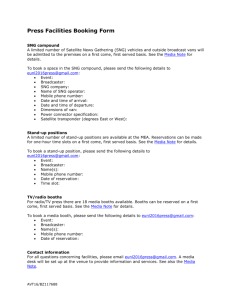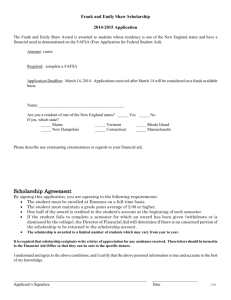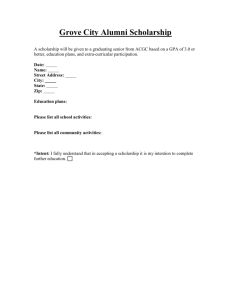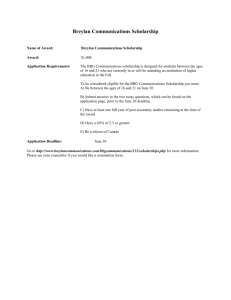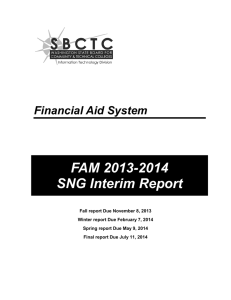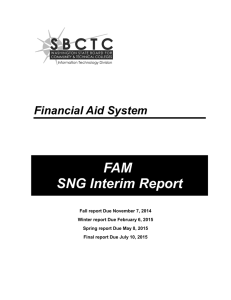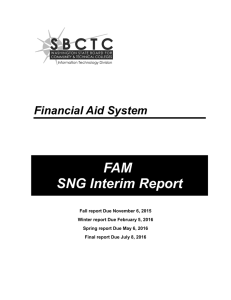College Readiness in Washington
advertisement
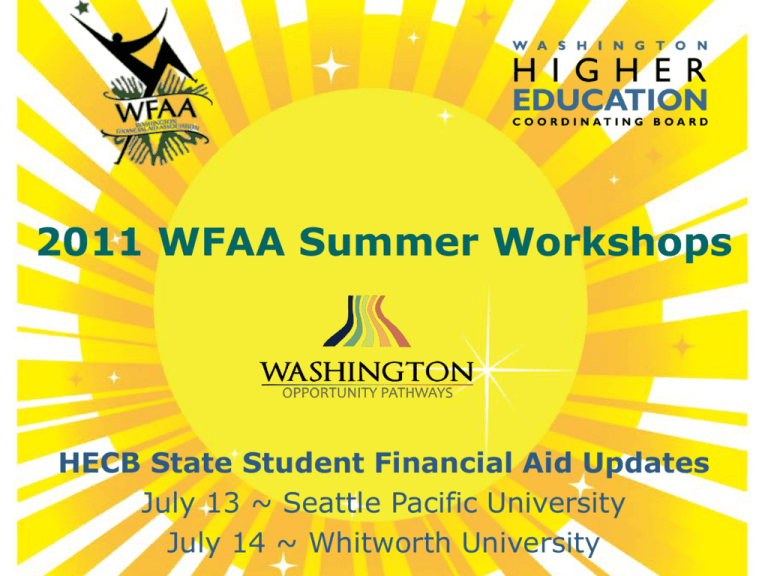
2011 WFAA Summer Workshops HECB State Student Financial Aid Updates July 13 ~ Seattle Pacific University July 14 ~ Whitworth University State Need Grant State Work Study Unit Record Reports/Data Coming soon… Opportunity Scholarship College Bound Scholarship Changes to governance Other FA information & awareness Training & assistance 2 State Need Grant • Over $266 million for 2011-12 assures lowest income students served by SNG attending public institutions protected from tuition increases • Continuing trend of un-served students – anticipating over 27,000 for 2010-11 Legislature provided direction to consider additional criteria besides “first-come, first-served” • Less-than-halftime eligibility continues without separate fund tracking 3 SNG policy reminders • “Self-help” must be 25% of budget or $3,433 $8.67 x12 hours x 33 weeks Work, loan, scholarships, EFC, unmet need (not Chafee ETV or Opportunity Grant) • Prioritization allowed Target lowest-income, returning recipients, nearing completion, etc. HECB will gather awarding policies to summarize • Report all eligible students regardless of whether your packaging policy leads them to not be served 4 SNG Awards Median Family Income Sector 0% - 50% 51% - 55% 55% - 60% 61% - 65% 66%-70% Research $ 9,280 $ 6,496 $ 6,032 $ 5,568 $ 4,640 Private Four Year DigiPen and NWCA (new students*) WWU $ 8,214 $ 5,750 $ 5,339 $ 4,928 $ 4,107 $ 4,107 $ 2,875 $ 2,670 $ 2,464 $ 2,054 $ 6,751 $ 4,726 $ 4,388 $ 4,051 $ 3,376 CWU, TESC $ 6,629 $ 4,640 $ 4,309 $ 3,977 $3,315 EWU $6,446 $ 4,512 $ 4,190 $ 3,868 $ 3,223 Community and Technical Colleges $ 3,256 $ 2,279 $ 2,116 $1,954 $1,628 Private Vocational $2,713 $1,899 $1,763 $1,628 $1,357 Private Vocational (new students*) $1,357 $ 950 $ 882 $ 814 $ 679 $ 862 $ 603 $ 560 $ 517 $ 431 2011-12 Dependent Care Allowance 5 CSAW • Replaces payment utility in portal and interim report in secure site & will accommodate College Bound awards Streamline & combine features of both processes Clearer interface to address edits • All privates convert to “running balance” method (GU & SU piloted) Adjustments made in portal Funds returned at year-end • Some publics will use for November interim report • Conversion for all by 2012 6 SNG timelines • Summer - review of July 8 SNG Final report and reconciliation • August - Convert $25 million reduction to SNG to “locally served” in portal (affects Archive Report, fund totals, etc.) • August – Private institutions begin using CSAW • Early Sept. - final reserves distribute remaining 10% of allocation • Fall 2011 – pilot public institutions begin using CSAW 7 State Work Study • Program funding drastically reduced to about $8 million (from $16 M last year or $23 M two years ago) • Anticipate there will be about 2,500 students participating from 9,000 two years ago • 2011-12 will focus on revised equitable distribution methods; maximizing student opportunity; utilization patterns and program advocacy 8 SWS policy reminders • Elimination of participation of non-resident students • Suspension of special projects (high demand, math/science teacher, community service) • Suspension of full-time work-study • Elimination of federal funding impacting TANF and Unemployment Insurance benefit calculations • Increased employer match rates 1,500 employers classified & renewed by HECB − − − For-profit ~ 60% On-campus/governmental ~ 40% Non-profit/school district/STEM ~ 30% 9 SWS timelines • July 15 – Public cash requests and year-end reports; private timesheets due • Late July – distribution of remaining 25% • August – reconciliation of 2010-11 • Sept. – distribution of any remaining carry-forward • Nov. – SFA Workgroup review of distribution model & policies • Fall & beyond – review and re-distribution of under-spent funds as needed 10 Unit Record Report Due date – October 7 • Trainings in August Highline Community College August 9 ~ 1-3 p.m. Joint training with SBCTC via webinar Sept. 1 ~ 2-4 p.m. • Changes: Don’t report Workforce and Opportunity Grant without FAFSA The $25 M mid-year reduction to State Need Grant − Some institutions report SNG, and report local funding in appropriate source. − Other institutions over-report SNG, the HECB will move the appropriate amount into “unserved-served with local funds” category. − The SNG Edits & Mismatch report will be disabled until after submission. − Three year summary in totals reports versus five. 11 2010-2011 FAFSA Application Dates by Income 20000 18000 16000 Independent Students 14000 <0 12000 0-10K 10000 10-30K 8000 6000 4000 2000 0 30-50K 50-70K 70-90K 90-110K >110K 14000 12000 Dependent Students 10000 <0 0-10K 8000 6000 10-30K 30-50K 50-70K 4000 2000 70-90K 90-110K >110K 0 12 13 Opportunity Scholarship – ESHB 2088 • Scholarships targeted to low- and middle-income resident students pursuing a bachelors in high demand areas. • A board with business representatives and other appointees created. • Program administered by College Success Foundation. • Private contributions and $5 million state match will fund scholarships. • Scholarships will be awarded December 2011. • CSF currently designing scholarship. 14 College Bound Scholarship • • • • Early commitment of enhanced State Need Grant Nearly 87,000 students have applied About 16,000 in the 2012 cohort Partners (CSF, GEAR UP, OSPI, NELA, and more) focusing on FAFSA completion and student support in addition to outreach • Meeting with campuses held to discuss identification and support of students beginning in 2012 • Summer will develop financial aid procedures and discussed at WFAA in October 15 College Bound Rules • Students have one year from high school graduation to enroll • Award combines with SNG to cover public T/F + $500 • Feb. 1 FAFSA deadline for SNG priority • Most policies same as SNG except: 65% MFI Four-year award within five years (12 quarters/8 semesters) High school graduation with 2.0 GPA 16 College Bound Processes • Students will be matched to FAFSA and presented to campuses via “cruncher” • HECB will communicated with matched students and those who appear ineligible or need to verify eligibility • Campuses will verify eligibility for those HECB cannot • CB award incorporated into CSAW reporting systems 17 Elimination of the HECB – E2SSB 5182 • Eliminates HECB effective July 1, 2012 • Replaces HECB with an Office of Student Financial Assistance and a Council on Higher Education (CHE) • Names Governor-appointed steering committee to determine role and scope of CHE functions • Steering committee recommendation due December 2011 • Assigns GET operations to new Student Financial Assistance Office 18 Next Steps • Strategic Master Plan (SMP) update • HECB and stakeholders/partners collaborate • Initial plan draft due at September 29 HECB meeting at WSU Tri Cities • Final SMP draft due at HECB November 17 meeting at UW Bothell • CHE steering committee formation − Report due December • Fall ‘Chautauquas’ − Tri-Cities, Ellensburg, Yakima, Seattle & Olympia 19 FA Training, Information & Awareness • June workshop feedback – in-person training in a convenient location appreciated • Program manuals – likely they will not be mailed next year • HECB will share a FA 101 .ppt with state aid information • HECB update at WCHSCR will be presented by SFA staff and include FA information • Developing video of FA students to share with Legislators • SFA will direct efforts to institutional training and assistance for new administrators and where data present questions 20 Questions? 21 SNG 2011-2012 MFI Chart MFIs for 2011-2012 SNG Program (rounded to nearest $500) Family Size 50% 55% 60% 65% 70% 1 21,000 23,500 25,500 27,500 29,500 2 28,000 30,500 33,500 36,000 39,000 3 34,500 37,500 41,000 44,500 48,000 4 41,000 45,000 49,000 53,000 57,000 5 47,500 52,000 57,000 61,500 66,500 6 54,000 59,500 64,500 70,000 75,500 7 55,000 60,500 66,000 71,500 77,000 8 56,500 62,000 67,500 73,500 79,000 9 57,500 63,500 69,000 75,000 80,500 10 59,000 64,500 70,500 76,500 82,500 Note: Maximum MFI range remains at 70% MFI. 22 MFI Range: Percentage of Award Percentage of full-time award covered at different MFI ranges MFI Range 2011-2012 Percentage of Award 0%-50% 100% 51%-55% 70% 56%-60% 65% 61%-65% 60% 66%-70% 50% • No changes from 2010-2011 23 Passport to College Provides scholarship and support services to students from foster care. • Data exchanges identify eligible students and monitor pipeline. • DSHS verifies eligibility through secure data match, enabling a postsecondary pipeline analysis. • Institutions developing innovative services for youth from care, and receive incentive payments. • College Success foundation providing outreach, student intervention, and community integration services. • Award amounts will be $3,000 in 2011-12 – summer term allowed. Year New Enrollees Continuing Total 2010-11 182 188 370 2009-10 220 98 318 2008-09 157 n/a 157 “Passport is a huge help in supporting my dreams.” – Passport recipient 24 The only Washington-focused scholarship matching resource available free of charge to both students and scholarship providers. • Both for Washington resident or students attending Washington institutions. • Serves all ages of students, from middle school to grad school. • Benefits students by helping them to find more scholarship opportunities. • Benefits providers by providing free advertising of their scholarship to potential applicant pool. theWashBoard.org by the Numbers: • More than 61,000 registered student seekers. • 200 scholarship providers participating • 36 SNG eligible institutions or foundations • $26m in anticipated awards listed this year 25 Federal SAP vs. State SAP • Most state SAP policies have been submitted; however, many questions remain regarding the burden of the two policies for state and federal aid. • Federal and state SAP requirements have always differed (term by term vs. annual; specific requirements regarding completion, etc.). • Maximum timeframe – 125% (state) vs. 150% (federal). • The federal “pace of progress” is a different computation than the “50% of completion.” • Any information regarding the two policies at play on your campus and how they determine SAP issues would be appreciated – the SFA Workgroup can review – data would be needed to evaluate potential changes. 26 GEAR UP GET Scholarship • Class of 2011 Scholars Project for GEAR UP uses GET to disburse funding. • About 530 scholars. • An Excel list will be uploaded to the secure site – and schools can sort to identify students by campus. • GEAR UP GET should be treated as a scholarship for packaging purposes. • If a student withdraws, refunds should be returned to GET. • GEAR UP GET will be identified separately from regular GET including a separate email accompanying the disbursement. Questions? Susan St. George at susans@hecb.wa.gov 27
![Bourse Loran Scholarship [formerly the CMSF National Award]](http://s3.studylib.net/store/data/008459991_1-b0aaf3db7ad79ae266d77380f9da023a-300x300.png)
